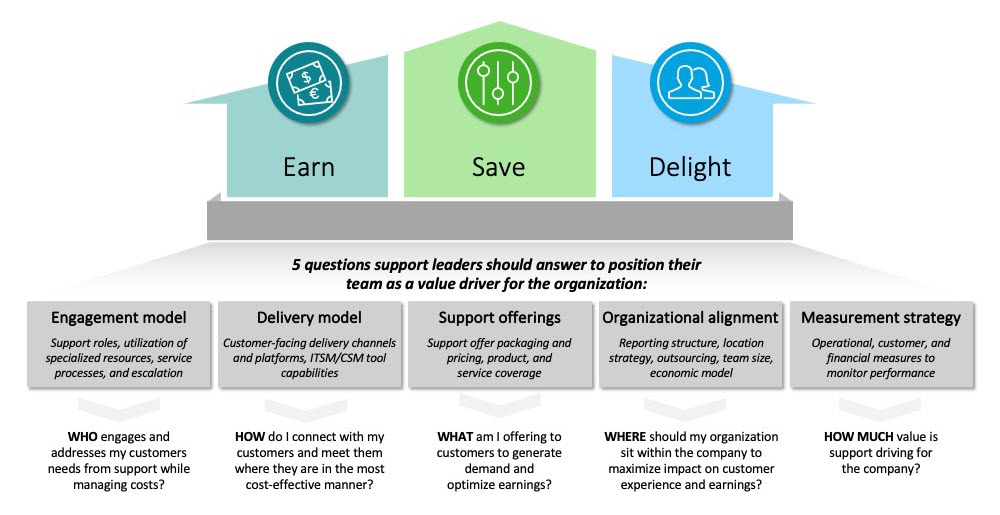Next-gen customer support in B2B high tech has been saved

Perspectives
Next-gen customer support in B2B high tech
Customer support in business-to-business (B2B) high tech is evolving—discover the strategic choices support organizations must make to elevate services and meet customer needs in today’s rapidly changing tech landscape.
The next generation of customer support in tech
While all eyes are on artificial intelligence (AI), specifically generative AI, as a panacea to achieving the goals of customer support organizations, there are foundational decisions for support leaders to make that go beyond technology. The right choices today have the potential to transform the customer support function into an ace up the sleeve of B2B tech companies—a key service offering differentiator, which is just as critical as go-to-market and product teams in driving efficient growth and value for organizations.
To understand how high-performing support teams differentiate themselves from the rest, Deloitte conducted a two-part study to determine how tech support leaders are evolving their organizations. We collected qualitative insights through detailed interviews, and then we leveraged a survey to get a broader set of perspectives to validate and quantify our findings. Given the rapidly evolving space and technological advancements, we then added insights from real-time conversations with subject-matter specialists and our clients.
Explore our full report for the findings.
Creating next-gen customer support: Strategic considerations
Based on our extensive work with customer support teams for technology companies focused on enterprise software products, high-performing customer support organizations1 are expanding their purview across three key value drivers and dedicating resources and efforts into building capabilities toward earning revenue, saving costs, and delighting customers2. Insights from the interviews and survey helped us identify the trade-offs support leaders are navigating as they evaluate options related to these five questions:

Click each tab to explore each question.
Who engages and addresses my customers’ needs from support while managing costs?
Our study showcased that support leaders are required to do a level of introspection to determine what model the support organization can perform successfully. While there is no “best model” for a support organization, there are five considerations a support leader should evaluate to design a model that meets the needs of its customers and company:
- Main goal of the support organization
- Skills and strengths of my current team
- Volume, complexity, and breadth of cases my team is seeing
- Teams supporting my organization, including where I have influence
- Skill levels of end users and extent of self-service options/communities available
While there are many nuances to engagement models, all permutations fall within three primary archetypes, and support leaders should balance between trade-offs before selecting a model for their organization. These are the typical engagement archetypes:
- Standard tiered model: The case is initially handled by a front-line team, who will escalate and pass ownership to more senior team members if they are unable to resolve a case.
- Direct-to-specialist model: The case ownership is routed to someone who specializes in the product or issue that the customer is facing.
- Swarming model: The case is owned by one team member throughout its life cycle, but other team members collaborate with the owner to solve the case.
Our study highlighted trade-offs among these options that impact the three value drivers of support: earning revenue, saving costs, and delighting customers. An organization needs to determine which value driver is of highest priority to identify which model archetype is best for it based on priorities, the complexity of the solution provided, and the expertise of its customer base.
How do I connect with my customers and meet them where they are in the most cost-effective manner?
Our study indicates that all companies use some combination of human and technology-based processes and tools to deliver support across a continuum. However, as technology has evolved, support organizations have had to keep up with new tools to meet customer needs and expectations. A support organization has choices on how to deliver and conduct support along the continuum, which can be broadly categorized as the following:
- Human-first: Support delivery relies on a human to be the primary driver of engagement and case resolution.
- Technology-first: This model is driven primarily by technology—automation, AI, customer journey orchestration—to engage users and resolve issues, and humans are brought in once the limits of tech capabilities have been reached.
- Human-delivered; technology-enabled: This model augments the human touch with technology to provide information to support engagement and case resolution using tools such as AI, customer data, and insights.
It will not come as a surprise to anyone that the days of email addresses and phone numbers as the primary means for support communication are well behind us and digital channels have taken over. However, this is not to say digital is the only way. Companies are most successful when they are “right-channeling”, leveraging the most cost effective and efficient channel for their customer.3
Our study further showcased that 70% of support leaders are prioritizing digital-first support in the near term to drive improved case deflection while also effectively managing their case load by triaging low-complexity, low-priority cases. To support this shift toward digital models, support leaders are looking to invest in new technologies ranging from omnichannel support for customers to integrated automation and generative AI.
What am I offering to the customers to generate demand and optimize earnings?
B2B support offerings focus on how services are packaged, priced, and sold to customers based on the tier, product, and service coverage. Most support organizations (71%) offer a combination of free and paid customer support services; however, we found that decisions around product coverage and packaging have greater impact on earning revenue, saving costs, and delighting customers than price alone. These are the leading options for product coverage and packaging for support organizations:
- Unified support offerings: Support is bundled across multiple products to provide enterprisewide coverage through a single plan.
- Product-aligned support offerings: Support coverage is sold to the customer by product, allowing for differing levels of support across products.
When it comes to structuring offerings for product coverage, 50% of companies in our study offered unified support plans across product offerings, and 40% offered support segmented by product. The remaining 10% of companies had various models unique to their situations, such as support segmented via deployment type (cloud vs. on-premises) or by customer size (as determined by employee headcount). While the study didn’t identify a leading product coverage strategy, it did provide context around the nuances of selecting the best approach for the specific company. Decisions around product coverage can have a different impact on the earn, save, and delight value drivers.
Where should my organization sit within the company to maximize impact on customer experience and earnings?
Our study showed that organization structure affected two main aspects of operating a support organization: alignment of priorities and collaboration dynamics within the organization. Support organizations most often reside in front-office or post-sales functions, such as marketing, sales, or customer success, with fewer support organizations sitting in product or operations functions. Of those surveyed, only 5% were independent parts of the organization.
Of the functions to house the support department—post-sales, product and operations, and front office—there were differences across leadership reporting and titles, offerings and response times, and workforce composition.
- Support departments within customer success and post-sales are more likely to provide a first response within five to 24 hours (free support), proactively reach out to customers, and have special processes for large-volume customers.
- Support departments within product and operations are more likely to have a leader report to a director or a manager and prioritize digital self-help, video chat, and social media channels. They are less likely to update customers from within a product or provide special processes that require a fee.
- Support departments within sales and marketing are more likely to have a leader with the title of president, provide a response within four hours (paid), employ support specialists, and provide special processes for first-time purchasers.
A previous study shared the importance of collaboration across post sales teams4, but the real question to ask is which structure will drive the most aligned priorities and collaboration? The answer is nuanced and specific to each company. Interview results shared anecdotal benefits and disadvantages, but performance and where support is aligned within the organization did not have a significant correlation.
What was highlighted in our data was that high-performing support departments reported an increased level of collaboration and influence with other functions, such as marketing, operations, customer success, and sales. The groups that support functions most commonly collaborate with are:
- Front office, including marketing and sales.
- Product, including engineering and development.
- Post-sales, including customer success.
Traditionally, support organizations are data-driven and live by their operational metrics. Our study showed that the most frequently used measures of support department success are mean time to resolve customer request (61%), mean time to respond to customers (53%), incidents prevented/proactive tickets (deflection) (41%), and number of support callbacks to check in with customers (41%).
High-performing support departments favor measuring mean time to resolve and mean time to respond while also identifying first-call resolution as a key success measure 2.6 times more often than low-performing departments. High-performing departments also incentivize their teams differently and are 1.3 times more likely to align support department performance bonuses to overall company success versus low-performing departments.
This was reinforced by our study when support leaders spoke about the evolution of metrics. Support leaders are moving toward shifting their metrics to overall company metrics because those align to future priorities of being a key value contributor. To understand, articulate, and share the value driven by support, organizations are shifting from primarily operational key performance indicators, such as resolution time, close rates, and escalations, to customer outcomes metrics, such as customer effort score, customer satisfaction, net promoter score (NPS), first-contact resolution, and net dollar retention (NDR)5. Based on our work with leading support departments, teams are also combining operational and customer metrics into a balanced scorecard to deploy a more well-rounded approach to delivering and measuring customer impact.
Additionally, an emerging trend in leading support organizations are metrics associated with product usability and intuitiveness. Effective support leaders are looking to highlight and measure the value they are providing in reducing product defects and developing more intuitive solutions for the customer.
At the end of the day, support leaders need to choose the measurement strategy by which they want to measure success and evaluate the impact they have on setting or defining the culture of the organization. Support leaders commonly choose among:
- Operational metrics: Measures of speed and efficiency, including resolution time, close rates, and escalations.
- Customer metrics: Measures of customer experience, including customer effort score, customer satisfaction, NPS, first-contact resolution, and retention.
- Balanced scorecard: Measures of both operational and customer metrics.
For more insights on creating high-performance customer support in today’s B2B high-tech landscape, download our full report.
Get in touch
${fourth-leader-name}
${fourth-leader-title}
${fourth-leader-additional-info}
${fourth-leader-name}
${fourth-leader-title}
${fourth-leader-additional-info}
Contributors: Gopal Srinivasan, Aftab Khanna, Murat Ozturk, and Rohan Gupta
Endnotes
1 For most support organizations, “high performance” means resolving or responding to a customer request in an expedited manner. Regardless of the metric used, we focused on those companies that outperform their internal expectations. The top 25% are the high-performing customer support departments that, by their own accord, are delivering excellent customer service.
2 Customer Experience stands out as a key value driver as companies who lead in customer experience are winning over customers and setting themselves apart as shown in our 2021 study, "Close the expectation gap with your B2B customers", by Tim Greulich, Gopal Srinivasan, and Deepak Sharma.
3 For more on "right-channeling" and other trends facing support and contact centers take a look at our latest contact center survey report at https://www.deloittedigital.com/us/en/offerings/customer-led-marketing/digitalcustomer/contact-center-survey.html
4 Gopal Srinivasan, Marybeth D’Souza, Deepak Sharma, Aftab Khana, Lindsey Cash and Anand Mohan, “Customer outcomes: The cornerstone of exponential growth” accessed July 24, 2023.
5 Rohan Gupta, Gopal Srinivasan, and Marybeth D’Souza, “The Growth of NDR as a measure of Enterprise SaaS performance” accessed July 24, 2023.
Recommendations
Customer outcomes: Cornerstone of exponential growth
Moving toward a customer outcome-centric strategy
AI in Post-Sales Customer Experience
See how enterprise companies can move beyond their current challenges and apply AI capabilities to enhance their post sales customer experience.








